PSYCHOLOGY. 1. WELLNESS AND WELLBEING Student’s Name Pr
VerifiedAdded on 2023/01/16
|13
|3072
|22
AI Summary
Contribute Materials
Your contribution can guide someone’s learning journey. Share your
documents today.
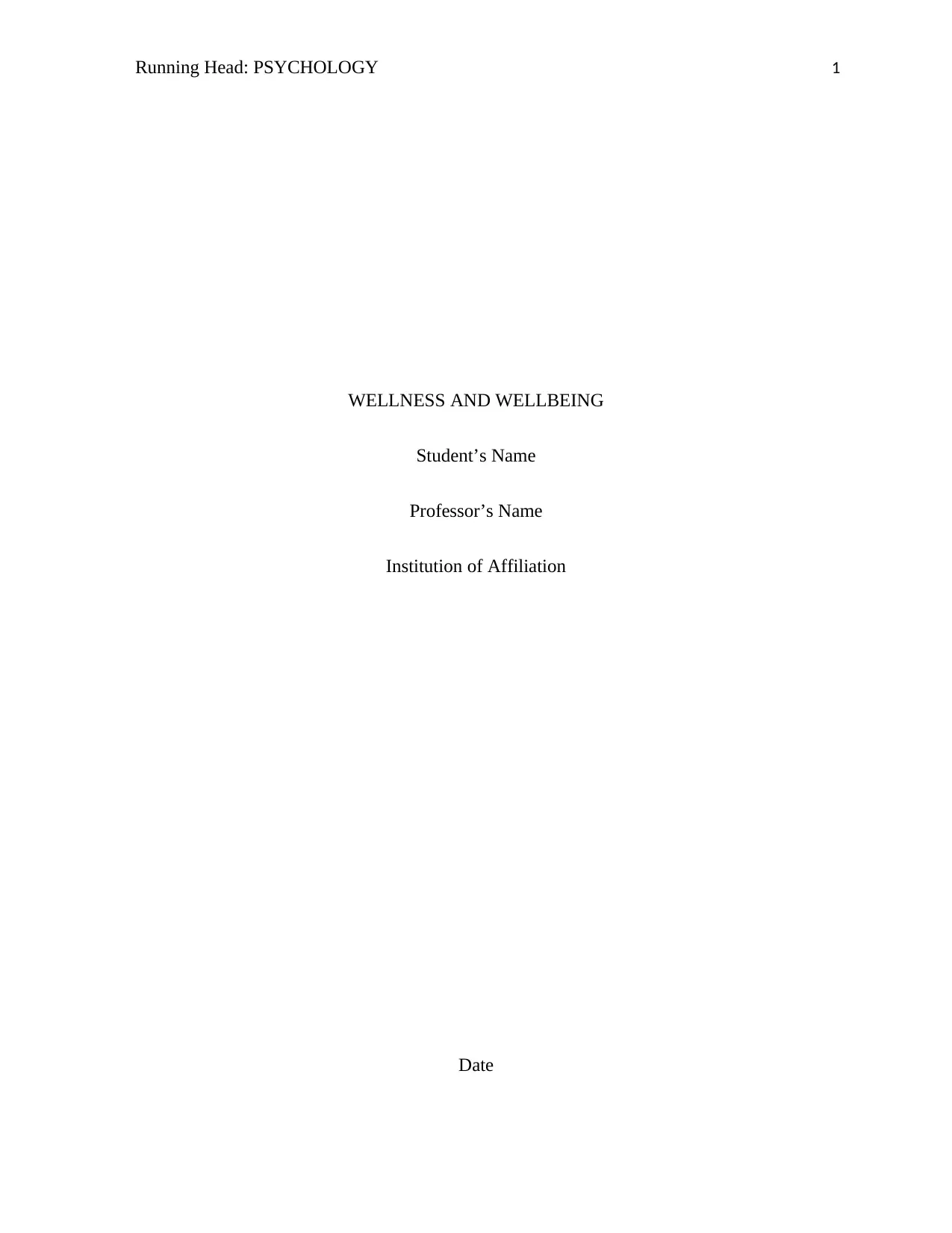
Running Head: PSYCHOLOGY 1
WELLNESS AND WELLBEING
Student’s Name
Professor’s Name
Institution of Affiliation
Date
WELLNESS AND WELLBEING
Student’s Name
Professor’s Name
Institution of Affiliation
Date
Secure Best Marks with AI Grader
Need help grading? Try our AI Grader for instant feedback on your assignments.
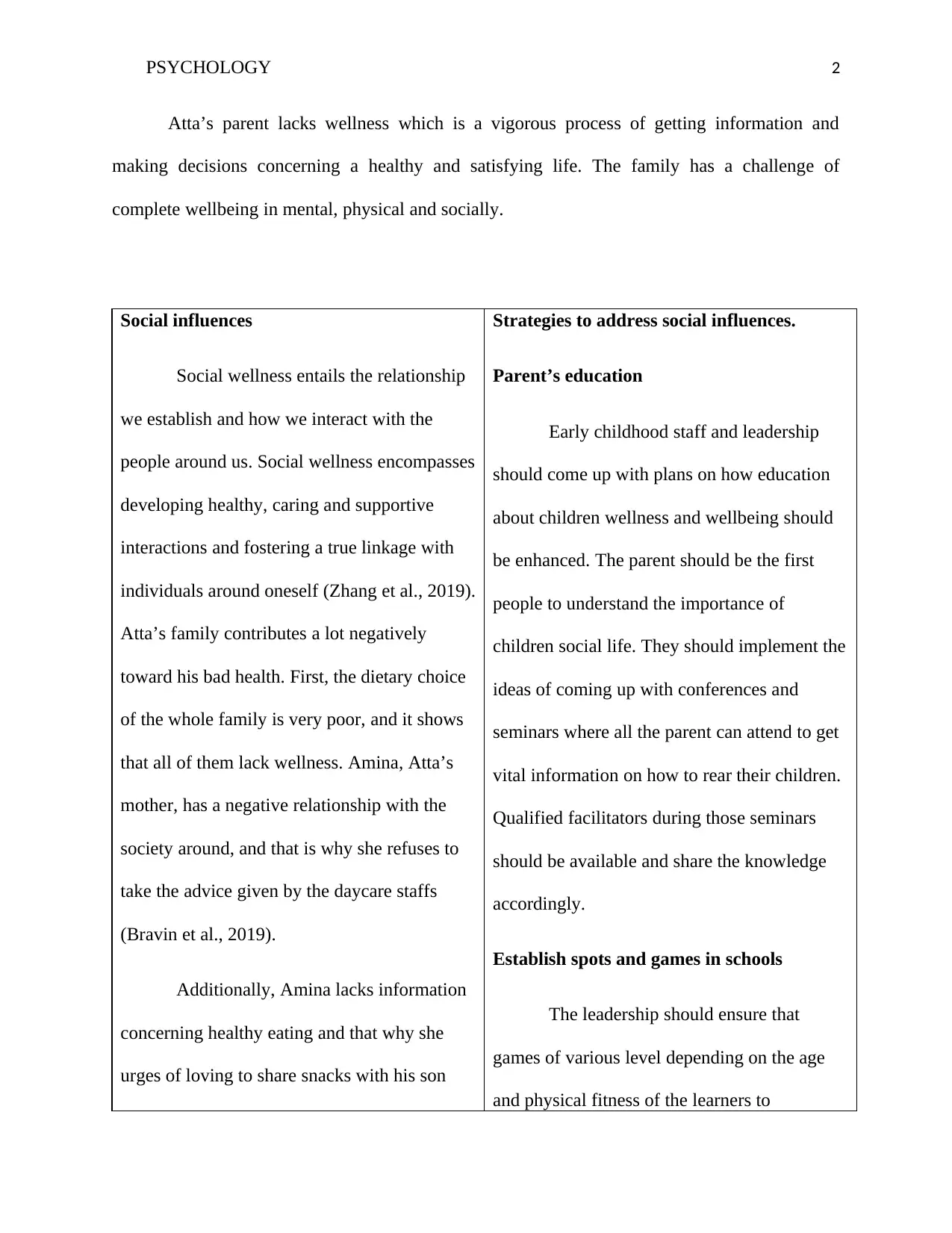
PSYCHOLOGY 2
Atta’s parent lacks wellness which is a vigorous process of getting information and
making decisions concerning a healthy and satisfying life. The family has a challenge of
complete wellbeing in mental, physical and socially.
Social influences
Social wellness entails the relationship
we establish and how we interact with the
people around us. Social wellness encompasses
developing healthy, caring and supportive
interactions and fostering a true linkage with
individuals around oneself (Zhang et al., 2019).
Atta’s family contributes a lot negatively
toward his bad health. First, the dietary choice
of the whole family is very poor, and it shows
that all of them lack wellness. Amina, Atta’s
mother, has a negative relationship with the
society around, and that is why she refuses to
take the advice given by the daycare staffs
(Bravin et al., 2019).
Additionally, Amina lacks information
concerning healthy eating and that why she
urges of loving to share snacks with his son
Strategies to address social influences.
Parent’s education
Early childhood staff and leadership
should come up with plans on how education
about children wellness and wellbeing should
be enhanced. The parent should be the first
people to understand the importance of
children social life. They should implement the
ideas of coming up with conferences and
seminars where all the parent can attend to get
vital information on how to rear their children.
Qualified facilitators during those seminars
should be available and share the knowledge
accordingly.
Establish spots and games in schools
The leadership should ensure that
games of various level depending on the age
and physical fitness of the learners to
Atta’s parent lacks wellness which is a vigorous process of getting information and
making decisions concerning a healthy and satisfying life. The family has a challenge of
complete wellbeing in mental, physical and socially.
Social influences
Social wellness entails the relationship
we establish and how we interact with the
people around us. Social wellness encompasses
developing healthy, caring and supportive
interactions and fostering a true linkage with
individuals around oneself (Zhang et al., 2019).
Atta’s family contributes a lot negatively
toward his bad health. First, the dietary choice
of the whole family is very poor, and it shows
that all of them lack wellness. Amina, Atta’s
mother, has a negative relationship with the
society around, and that is why she refuses to
take the advice given by the daycare staffs
(Bravin et al., 2019).
Additionally, Amina lacks information
concerning healthy eating and that why she
urges of loving to share snacks with his son
Strategies to address social influences.
Parent’s education
Early childhood staff and leadership
should come up with plans on how education
about children wellness and wellbeing should
be enhanced. The parent should be the first
people to understand the importance of
children social life. They should implement the
ideas of coming up with conferences and
seminars where all the parent can attend to get
vital information on how to rear their children.
Qualified facilitators during those seminars
should be available and share the knowledge
accordingly.
Establish spots and games in schools
The leadership should ensure that
games of various level depending on the age
and physical fitness of the learners to

PSYCHOLOGY 3
while they are watching. Atta’s obese
condition makes him experience social trauma
since other children call him names and talks
annoying words about him. The peer insults
make Atta less interested in interacting, which
affects even the exercise part of his life as he
cannot play with the age mate. Also, Atta’s
father is continuously busy due to work, and he
also has no ideas concerning health
maintenance hence, tells the daycare people
that the son likes sugary food staffs (Harbec, &
Pagani, 2018).
Media is another social influence factor
that has greatly interfered with the social life of
the family, mostly the mother and the son. Atta
likes the food that he watches on television,
which she insists on mostly the food with
colors. Media has contributed negatively
towards the wellbeing and wellness of Atta’s
life. Social media is currently the worse and
most influencing to the life of many
Australians because much time spent on it and
people tend to do what they see there (Zhang,
implemented. Every class should have a
specific game day that will be supervised by
the teacher and games couch, to ensure that
learner get exercise while at school even if they
don’t get it at home. Games contribute to peer
socialization and the establishment of good
relationships among them.
Education onsocialization matter in schools.
Children need education on how to
socialize well with others by their teachers. A
teacher can use an activity-based book to show
the children different cases where they are
supposed to interact. Social skill helps the
children to develop the heart of socializing and
becoming a good person in society as they
grow (Gerlach, Browne, & Suto, 2018). The
following are the way which can be used by
the teacher to enhance social skills.
Coaching on spot
Giving effective approval
Exhibiting appropriate behavior
while they are watching. Atta’s obese
condition makes him experience social trauma
since other children call him names and talks
annoying words about him. The peer insults
make Atta less interested in interacting, which
affects even the exercise part of his life as he
cannot play with the age mate. Also, Atta’s
father is continuously busy due to work, and he
also has no ideas concerning health
maintenance hence, tells the daycare people
that the son likes sugary food staffs (Harbec, &
Pagani, 2018).
Media is another social influence factor
that has greatly interfered with the social life of
the family, mostly the mother and the son. Atta
likes the food that he watches on television,
which she insists on mostly the food with
colors. Media has contributed negatively
towards the wellbeing and wellness of Atta’s
life. Social media is currently the worse and
most influencing to the life of many
Australians because much time spent on it and
people tend to do what they see there (Zhang,
implemented. Every class should have a
specific game day that will be supervised by
the teacher and games couch, to ensure that
learner get exercise while at school even if they
don’t get it at home. Games contribute to peer
socialization and the establishment of good
relationships among them.
Education onsocialization matter in schools.
Children need education on how to
socialize well with others by their teachers. A
teacher can use an activity-based book to show
the children different cases where they are
supposed to interact. Social skill helps the
children to develop the heart of socializing and
becoming a good person in society as they
grow (Gerlach, Browne, & Suto, 2018). The
following are the way which can be used by
the teacher to enhance social skills.
Coaching on spot
Giving effective approval
Exhibiting appropriate behavior
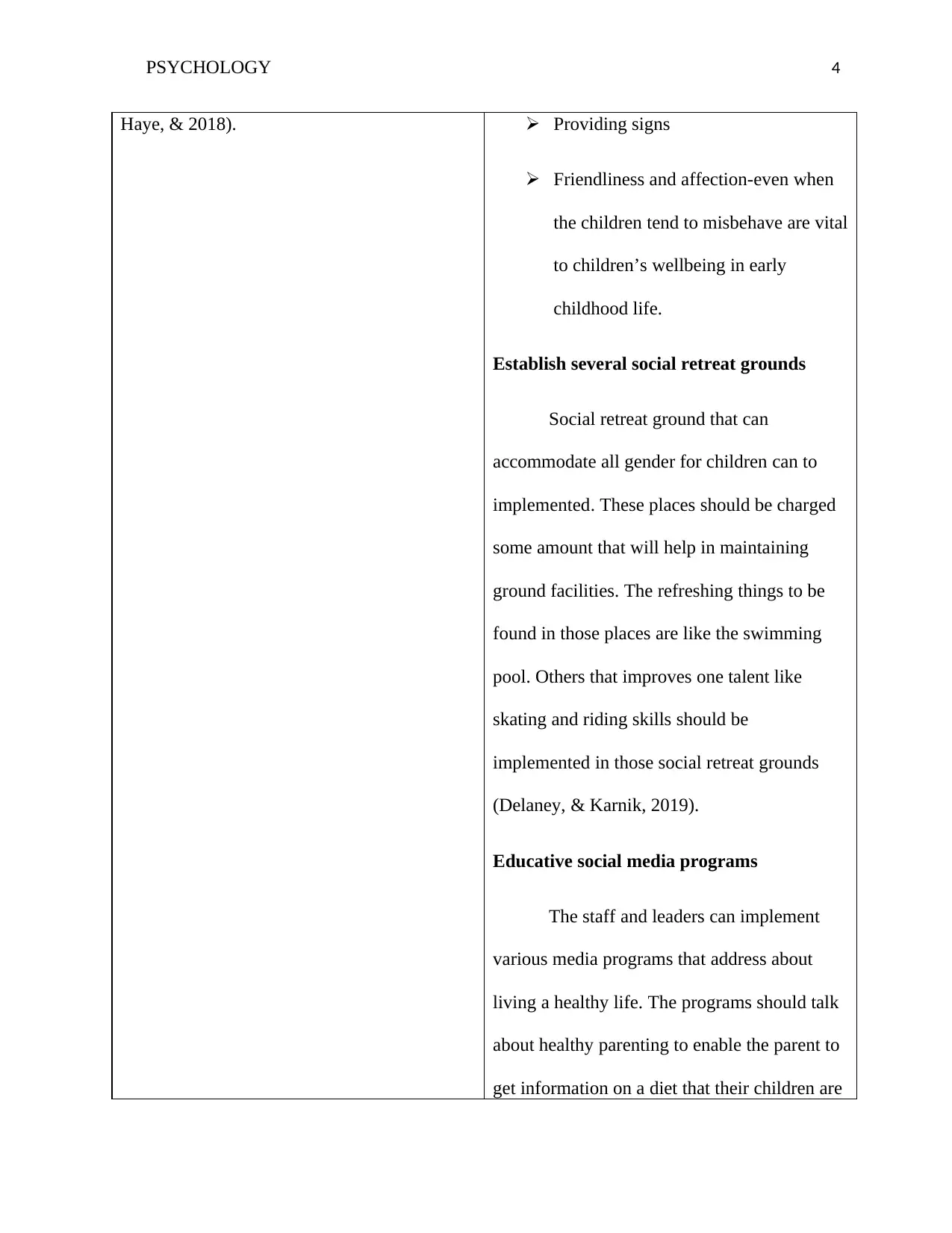
PSYCHOLOGY 4
Haye, & 2018). Providing signs
Friendliness and affection-even when
the children tend to misbehave are vital
to children’s wellbeing in early
childhood life.
Establish several social retreat grounds
Social retreat ground that can
accommodate all gender for children can to
implemented. These places should be charged
some amount that will help in maintaining
ground facilities. The refreshing things to be
found in those places are like the swimming
pool. Others that improves one talent like
skating and riding skills should be
implemented in those social retreat grounds
(Delaney, & Karnik, 2019).
Educative social media programs
The staff and leaders can implement
various media programs that address about
living a healthy life. The programs should talk
about healthy parenting to enable the parent to
get information on a diet that their children are
Haye, & 2018). Providing signs
Friendliness and affection-even when
the children tend to misbehave are vital
to children’s wellbeing in early
childhood life.
Establish several social retreat grounds
Social retreat ground that can
accommodate all gender for children can to
implemented. These places should be charged
some amount that will help in maintaining
ground facilities. The refreshing things to be
found in those places are like the swimming
pool. Others that improves one talent like
skating and riding skills should be
implemented in those social retreat grounds
(Delaney, & Karnik, 2019).
Educative social media programs
The staff and leaders can implement
various media programs that address about
living a healthy life. The programs should talk
about healthy parenting to enable the parent to
get information on a diet that their children are
Secure Best Marks with AI Grader
Need help grading? Try our AI Grader for instant feedback on your assignments.
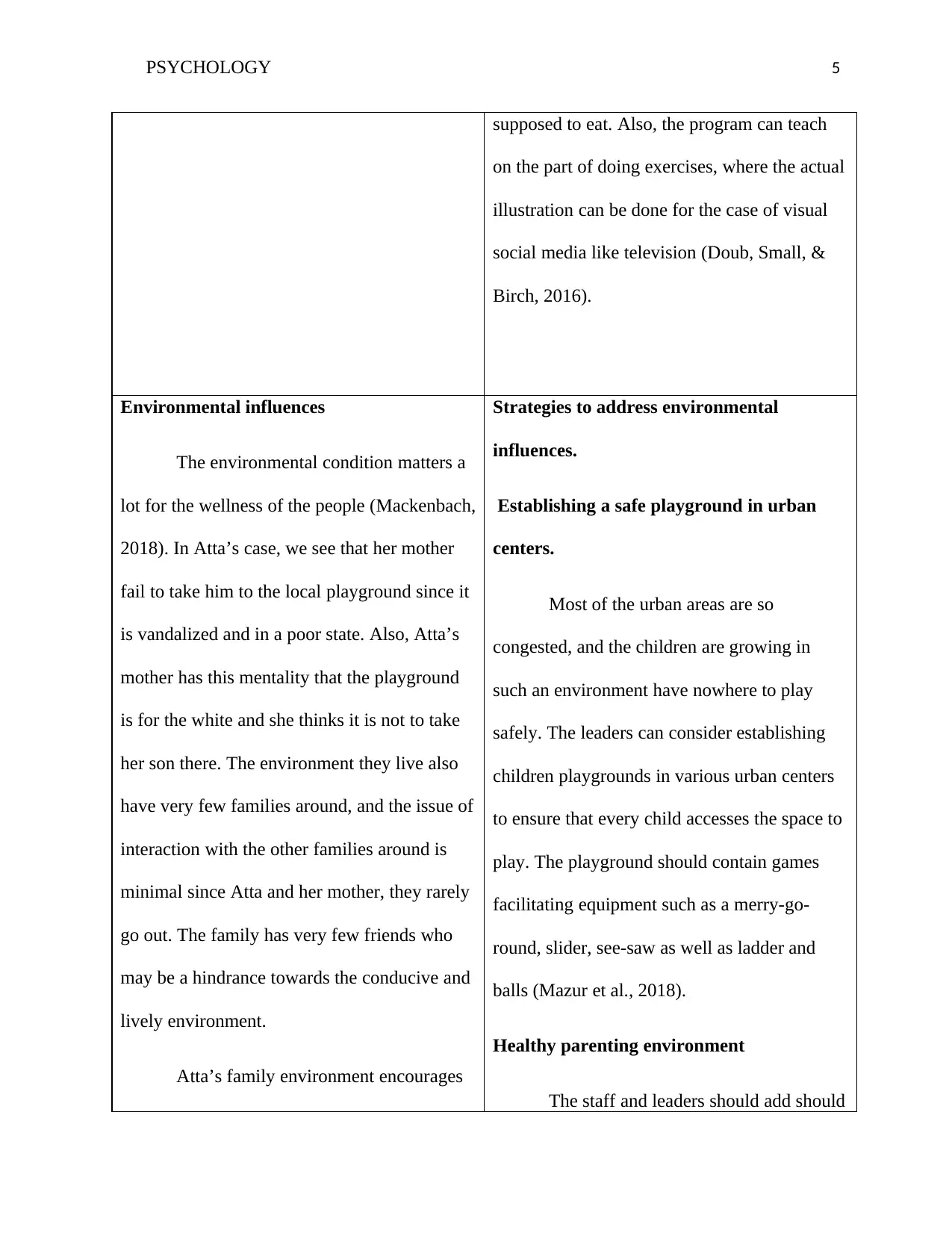
PSYCHOLOGY 5
supposed to eat. Also, the program can teach
on the part of doing exercises, where the actual
illustration can be done for the case of visual
social media like television (Doub, Small, &
Birch, 2016).
Environmental influences
The environmental condition matters a
lot for the wellness of the people (Mackenbach,
2018). In Atta’s case, we see that her mother
fail to take him to the local playground since it
is vandalized and in a poor state. Also, Atta’s
mother has this mentality that the playground
is for the white and she thinks it is not to take
her son there. The environment they live also
have very few families around, and the issue of
interaction with the other families around is
minimal since Atta and her mother, they rarely
go out. The family has very few friends who
may be a hindrance towards the conducive and
lively environment.
Atta’s family environment encourages
Strategies to address environmental
influences.
Establishing a safe playground in urban
centers.
Most of the urban areas are so
congested, and the children are growing in
such an environment have nowhere to play
safely. The leaders can consider establishing
children playgrounds in various urban centers
to ensure that every child accesses the space to
play. The playground should contain games
facilitating equipment such as a merry-go-
round, slider, see-saw as well as ladder and
balls (Mazur et al., 2018).
Healthy parenting environment
The staff and leaders should add should
supposed to eat. Also, the program can teach
on the part of doing exercises, where the actual
illustration can be done for the case of visual
social media like television (Doub, Small, &
Birch, 2016).
Environmental influences
The environmental condition matters a
lot for the wellness of the people (Mackenbach,
2018). In Atta’s case, we see that her mother
fail to take him to the local playground since it
is vandalized and in a poor state. Also, Atta’s
mother has this mentality that the playground
is for the white and she thinks it is not to take
her son there. The environment they live also
have very few families around, and the issue of
interaction with the other families around is
minimal since Atta and her mother, they rarely
go out. The family has very few friends who
may be a hindrance towards the conducive and
lively environment.
Atta’s family environment encourages
Strategies to address environmental
influences.
Establishing a safe playground in urban
centers.
Most of the urban areas are so
congested, and the children are growing in
such an environment have nowhere to play
safely. The leaders can consider establishing
children playgrounds in various urban centers
to ensure that every child accesses the space to
play. The playground should contain games
facilitating equipment such as a merry-go-
round, slider, see-saw as well as ladder and
balls (Mazur et al., 2018).
Healthy parenting environment
The staff and leaders should add should
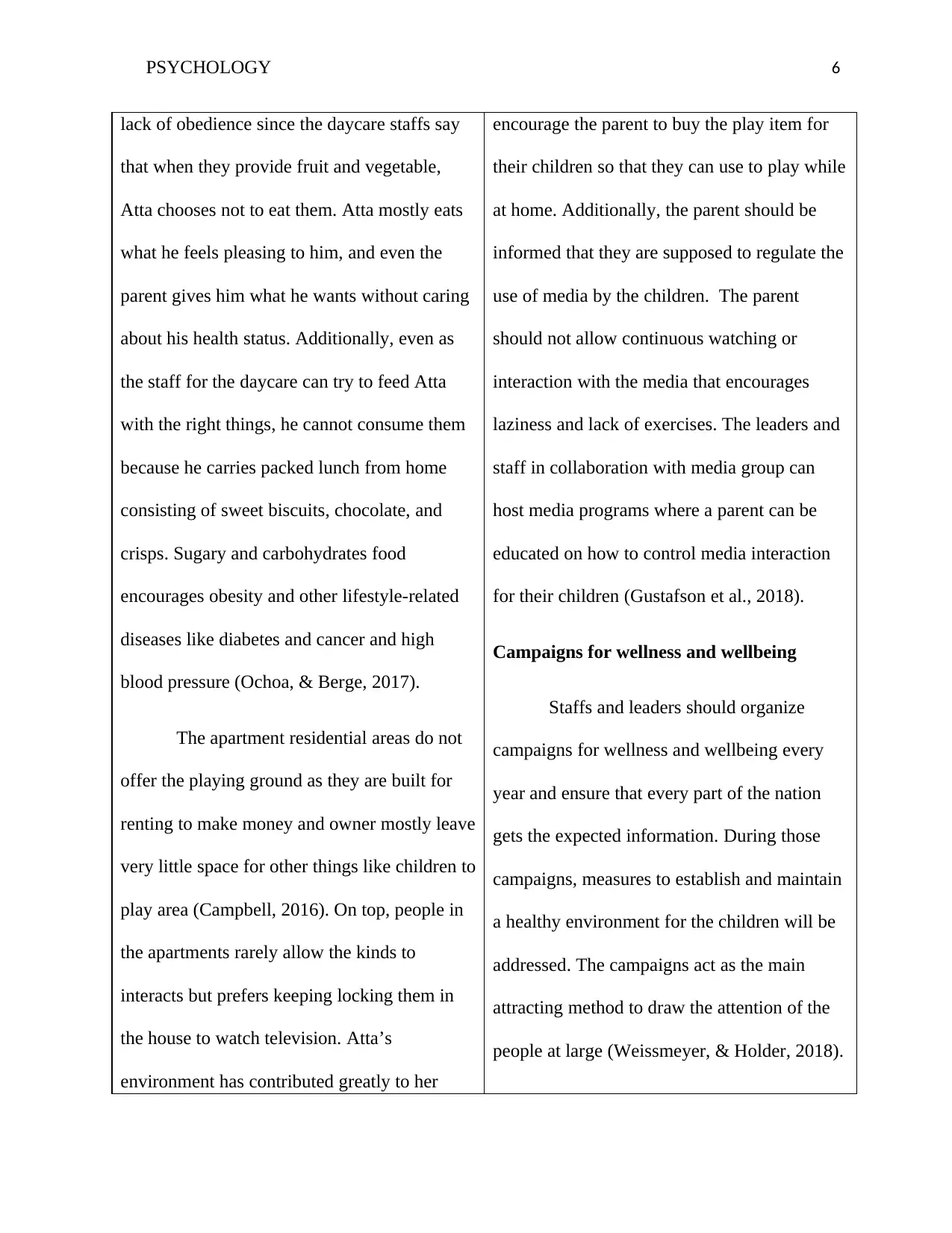
PSYCHOLOGY 6
lack of obedience since the daycare staffs say
that when they provide fruit and vegetable,
Atta chooses not to eat them. Atta mostly eats
what he feels pleasing to him, and even the
parent gives him what he wants without caring
about his health status. Additionally, even as
the staff for the daycare can try to feed Atta
with the right things, he cannot consume them
because he carries packed lunch from home
consisting of sweet biscuits, chocolate, and
crisps. Sugary and carbohydrates food
encourages obesity and other lifestyle-related
diseases like diabetes and cancer and high
blood pressure (Ochoa, & Berge, 2017).
The apartment residential areas do not
offer the playing ground as they are built for
renting to make money and owner mostly leave
very little space for other things like children to
play area (Campbell, 2016). On top, people in
the apartments rarely allow the kinds to
interacts but prefers keeping locking them in
the house to watch television. Atta’s
environment has contributed greatly to her
encourage the parent to buy the play item for
their children so that they can use to play while
at home. Additionally, the parent should be
informed that they are supposed to regulate the
use of media by the children. The parent
should not allow continuous watching or
interaction with the media that encourages
laziness and lack of exercises. The leaders and
staff in collaboration with media group can
host media programs where a parent can be
educated on how to control media interaction
for their children (Gustafson et al., 2018).
Campaigns for wellness and wellbeing
Staffs and leaders should organize
campaigns for wellness and wellbeing every
year and ensure that every part of the nation
gets the expected information. During those
campaigns, measures to establish and maintain
a healthy environment for the children will be
addressed. The campaigns act as the main
attracting method to draw the attention of the
people at large (Weissmeyer, & Holder, 2018).
lack of obedience since the daycare staffs say
that when they provide fruit and vegetable,
Atta chooses not to eat them. Atta mostly eats
what he feels pleasing to him, and even the
parent gives him what he wants without caring
about his health status. Additionally, even as
the staff for the daycare can try to feed Atta
with the right things, he cannot consume them
because he carries packed lunch from home
consisting of sweet biscuits, chocolate, and
crisps. Sugary and carbohydrates food
encourages obesity and other lifestyle-related
diseases like diabetes and cancer and high
blood pressure (Ochoa, & Berge, 2017).
The apartment residential areas do not
offer the playing ground as they are built for
renting to make money and owner mostly leave
very little space for other things like children to
play area (Campbell, 2016). On top, people in
the apartments rarely allow the kinds to
interacts but prefers keeping locking them in
the house to watch television. Atta’s
environment has contributed greatly to her
encourage the parent to buy the play item for
their children so that they can use to play while
at home. Additionally, the parent should be
informed that they are supposed to regulate the
use of media by the children. The parent
should not allow continuous watching or
interaction with the media that encourages
laziness and lack of exercises. The leaders and
staff in collaboration with media group can
host media programs where a parent can be
educated on how to control media interaction
for their children (Gustafson et al., 2018).
Campaigns for wellness and wellbeing
Staffs and leaders should organize
campaigns for wellness and wellbeing every
year and ensure that every part of the nation
gets the expected information. During those
campaigns, measures to establish and maintain
a healthy environment for the children will be
addressed. The campaigns act as the main
attracting method to draw the attention of the
people at large (Weissmeyer, & Holder, 2018).
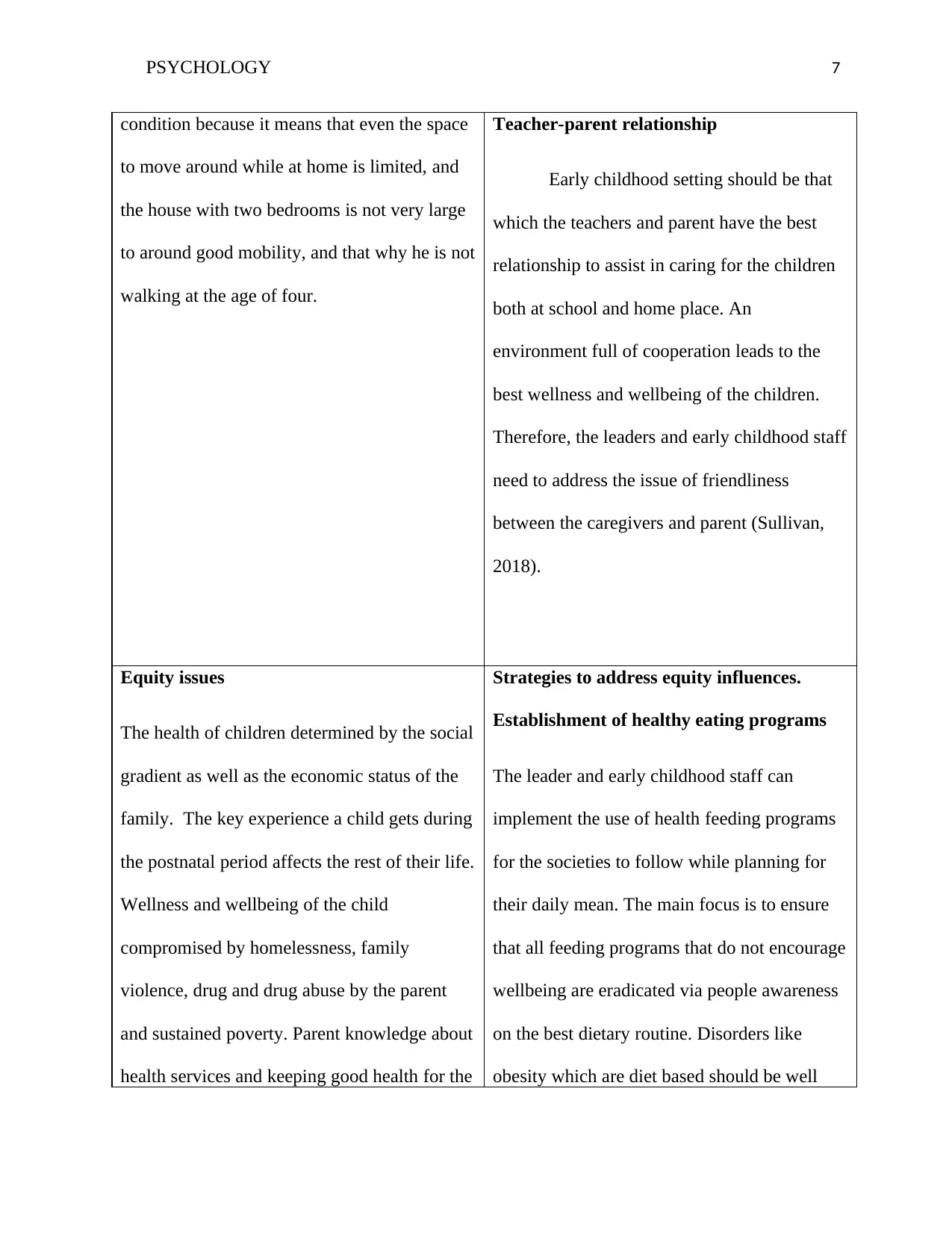
PSYCHOLOGY 7
condition because it means that even the space
to move around while at home is limited, and
the house with two bedrooms is not very large
to around good mobility, and that why he is not
walking at the age of four.
Teacher-parent relationship
Early childhood setting should be that
which the teachers and parent have the best
relationship to assist in caring for the children
both at school and home place. An
environment full of cooperation leads to the
best wellness and wellbeing of the children.
Therefore, the leaders and early childhood staff
need to address the issue of friendliness
between the caregivers and parent (Sullivan,
2018).
Equity issues
The health of children determined by the social
gradient as well as the economic status of the
family. The key experience a child gets during
the postnatal period affects the rest of their life.
Wellness and wellbeing of the child
compromised by homelessness, family
violence, drug and drug abuse by the parent
and sustained poverty. Parent knowledge about
health services and keeping good health for the
Strategies to address equity influences.
Establishment of healthy eating programs
The leader and early childhood staff can
implement the use of health feeding programs
for the societies to follow while planning for
their daily mean. The main focus is to ensure
that all feeding programs that do not encourage
wellbeing are eradicated via people awareness
on the best dietary routine. Disorders like
obesity which are diet based should be well
condition because it means that even the space
to move around while at home is limited, and
the house with two bedrooms is not very large
to around good mobility, and that why he is not
walking at the age of four.
Teacher-parent relationship
Early childhood setting should be that
which the teachers and parent have the best
relationship to assist in caring for the children
both at school and home place. An
environment full of cooperation leads to the
best wellness and wellbeing of the children.
Therefore, the leaders and early childhood staff
need to address the issue of friendliness
between the caregivers and parent (Sullivan,
2018).
Equity issues
The health of children determined by the social
gradient as well as the economic status of the
family. The key experience a child gets during
the postnatal period affects the rest of their life.
Wellness and wellbeing of the child
compromised by homelessness, family
violence, drug and drug abuse by the parent
and sustained poverty. Parent knowledge about
health services and keeping good health for the
Strategies to address equity influences.
Establishment of healthy eating programs
The leader and early childhood staff can
implement the use of health feeding programs
for the societies to follow while planning for
their daily mean. The main focus is to ensure
that all feeding programs that do not encourage
wellbeing are eradicated via people awareness
on the best dietary routine. Disorders like
obesity which are diet based should be well
Paraphrase This Document
Need a fresh take? Get an instant paraphrase of this document with our AI Paraphraser
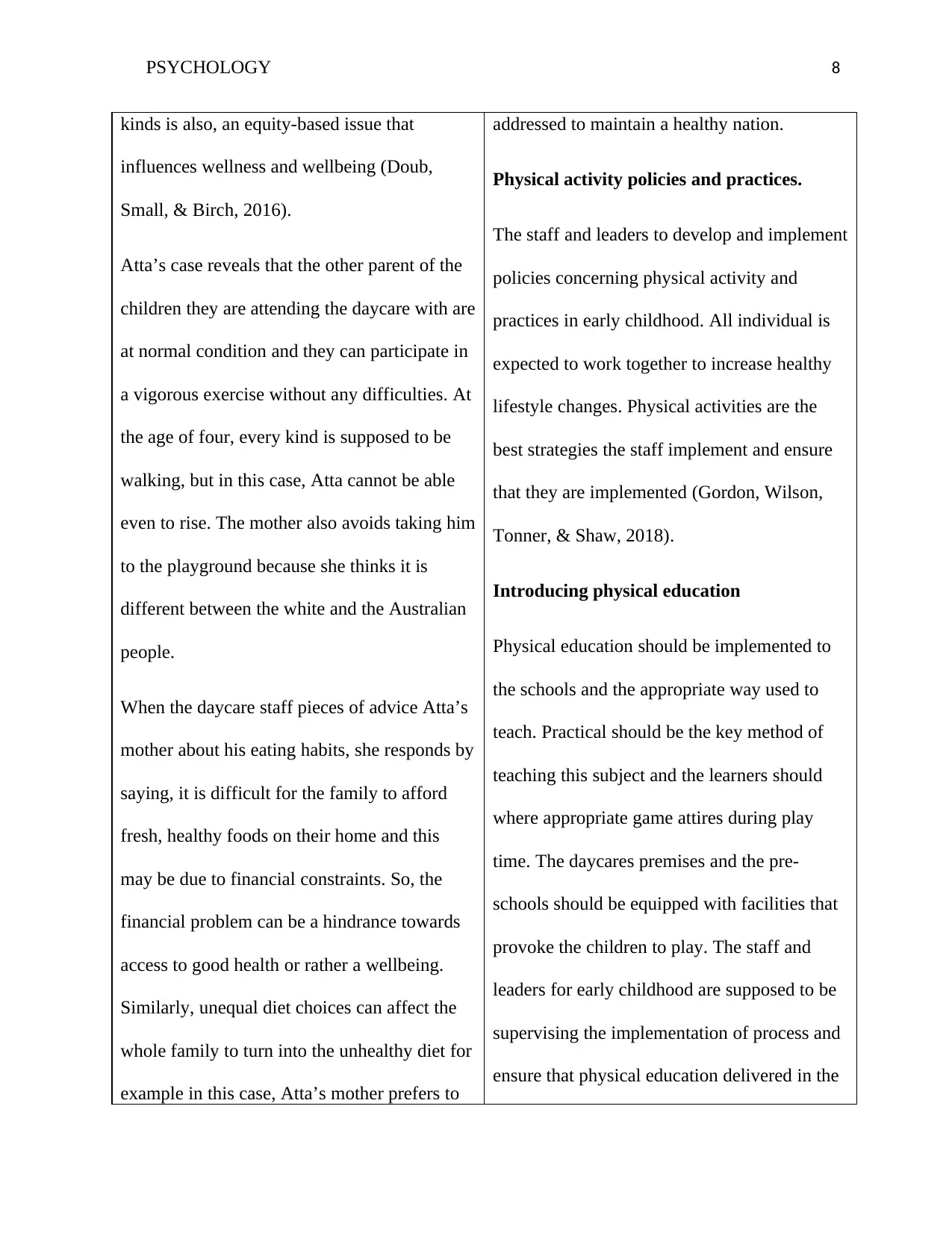
PSYCHOLOGY 8
kinds is also, an equity-based issue that
influences wellness and wellbeing (Doub,
Small, & Birch, 2016).
Atta’s case reveals that the other parent of the
children they are attending the daycare with are
at normal condition and they can participate in
a vigorous exercise without any difficulties. At
the age of four, every kind is supposed to be
walking, but in this case, Atta cannot be able
even to rise. The mother also avoids taking him
to the playground because she thinks it is
different between the white and the Australian
people.
When the daycare staff pieces of advice Atta’s
mother about his eating habits, she responds by
saying, it is difficult for the family to afford
fresh, healthy foods on their home and this
may be due to financial constraints. So, the
financial problem can be a hindrance towards
access to good health or rather a wellbeing.
Similarly, unequal diet choices can affect the
whole family to turn into the unhealthy diet for
example in this case, Atta’s mother prefers to
addressed to maintain a healthy nation.
Physical activity policies and practices.
The staff and leaders to develop and implement
policies concerning physical activity and
practices in early childhood. All individual is
expected to work together to increase healthy
lifestyle changes. Physical activities are the
best strategies the staff implement and ensure
that they are implemented (Gordon, Wilson,
Tonner, & Shaw, 2018).
Introducing physical education
Physical education should be implemented to
the schools and the appropriate way used to
teach. Practical should be the key method of
teaching this subject and the learners should
where appropriate game attires during play
time. The daycares premises and the pre-
schools should be equipped with facilities that
provoke the children to play. The staff and
leaders for early childhood are supposed to be
supervising the implementation of process and
ensure that physical education delivered in the
kinds is also, an equity-based issue that
influences wellness and wellbeing (Doub,
Small, & Birch, 2016).
Atta’s case reveals that the other parent of the
children they are attending the daycare with are
at normal condition and they can participate in
a vigorous exercise without any difficulties. At
the age of four, every kind is supposed to be
walking, but in this case, Atta cannot be able
even to rise. The mother also avoids taking him
to the playground because she thinks it is
different between the white and the Australian
people.
When the daycare staff pieces of advice Atta’s
mother about his eating habits, she responds by
saying, it is difficult for the family to afford
fresh, healthy foods on their home and this
may be due to financial constraints. So, the
financial problem can be a hindrance towards
access to good health or rather a wellbeing.
Similarly, unequal diet choices can affect the
whole family to turn into the unhealthy diet for
example in this case, Atta’s mother prefers to
addressed to maintain a healthy nation.
Physical activity policies and practices.
The staff and leaders to develop and implement
policies concerning physical activity and
practices in early childhood. All individual is
expected to work together to increase healthy
lifestyle changes. Physical activities are the
best strategies the staff implement and ensure
that they are implemented (Gordon, Wilson,
Tonner, & Shaw, 2018).
Introducing physical education
Physical education should be implemented to
the schools and the appropriate way used to
teach. Practical should be the key method of
teaching this subject and the learners should
where appropriate game attires during play
time. The daycares premises and the pre-
schools should be equipped with facilities that
provoke the children to play. The staff and
leaders for early childhood are supposed to be
supervising the implementation of process and
ensure that physical education delivered in the

PSYCHOLOGY 9
adhere to the meal that her son like most since
she cannot afford to see him wasting food
when she fails to give him the food that wants.
best quality (Barkley, Svetaz, & Chulani,
2019).
Quality facilities and resources.
The leaders are supposed to ensure that every
early childhood institution is endowed with
necessary facilities and resources for kids to
use while playing. The facilities are to be
managed well to ensure that they are safe to be
used all the time and prevent them from
damage. High level of maintenance should be
observed.
In conclusion, wellness and wellbeing can be embraced if all people work together to
improve on the two. Families, day care staffs, leaders, education institution, media programs are
all crucial, and if all take part in advocating for wellness and wellbeing for the people, we can
achieve a healthy society. The education and knowledge receive concerning wellness and
wellbeing should be put into practice to get a good result.
adhere to the meal that her son like most since
she cannot afford to see him wasting food
when she fails to give him the food that wants.
best quality (Barkley, Svetaz, & Chulani,
2019).
Quality facilities and resources.
The leaders are supposed to ensure that every
early childhood institution is endowed with
necessary facilities and resources for kids to
use while playing. The facilities are to be
managed well to ensure that they are safe to be
used all the time and prevent them from
damage. High level of maintenance should be
observed.
In conclusion, wellness and wellbeing can be embraced if all people work together to
improve on the two. Families, day care staffs, leaders, education institution, media programs are
all crucial, and if all take part in advocating for wellness and wellbeing for the people, we can
achieve a healthy society. The education and knowledge receive concerning wellness and
wellbeing should be put into practice to get a good result.
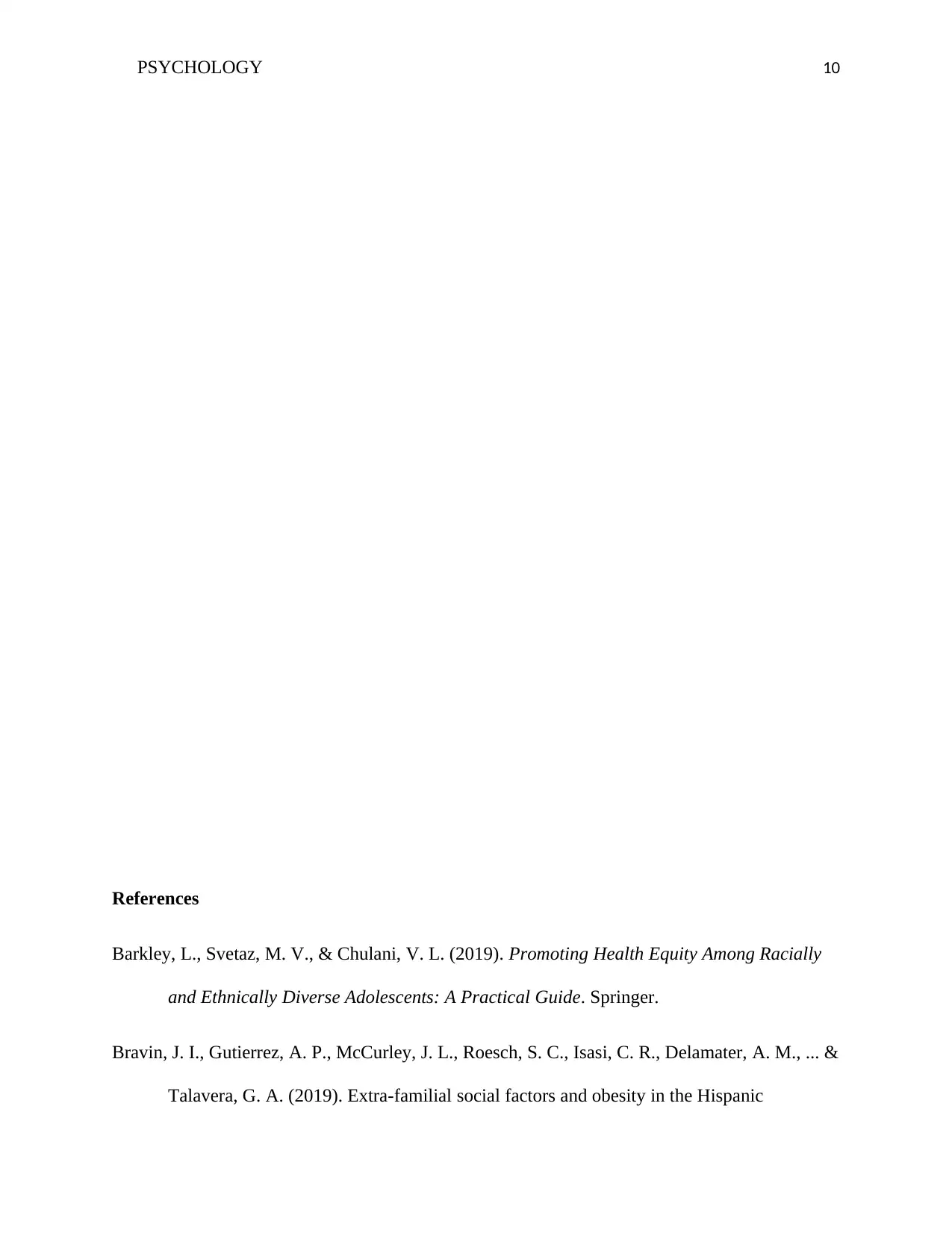
PSYCHOLOGY 10
References
Barkley, L., Svetaz, M. V., & Chulani, V. L. (2019). Promoting Health Equity Among Racially
and Ethnically Diverse Adolescents: A Practical Guide. Springer.
Bravin, J. I., Gutierrez, A. P., McCurley, J. L., Roesch, S. C., Isasi, C. R., Delamater, A. M., ... &
Talavera, G. A. (2019). Extra-familial social factors and obesity in the Hispanic
References
Barkley, L., Svetaz, M. V., & Chulani, V. L. (2019). Promoting Health Equity Among Racially
and Ethnically Diverse Adolescents: A Practical Guide. Springer.
Bravin, J. I., Gutierrez, A. P., McCurley, J. L., Roesch, S. C., Isasi, C. R., Delamater, A. M., ... &
Talavera, G. A. (2019). Extra-familial social factors and obesity in the Hispanic
Secure Best Marks with AI Grader
Need help grading? Try our AI Grader for instant feedback on your assignments.
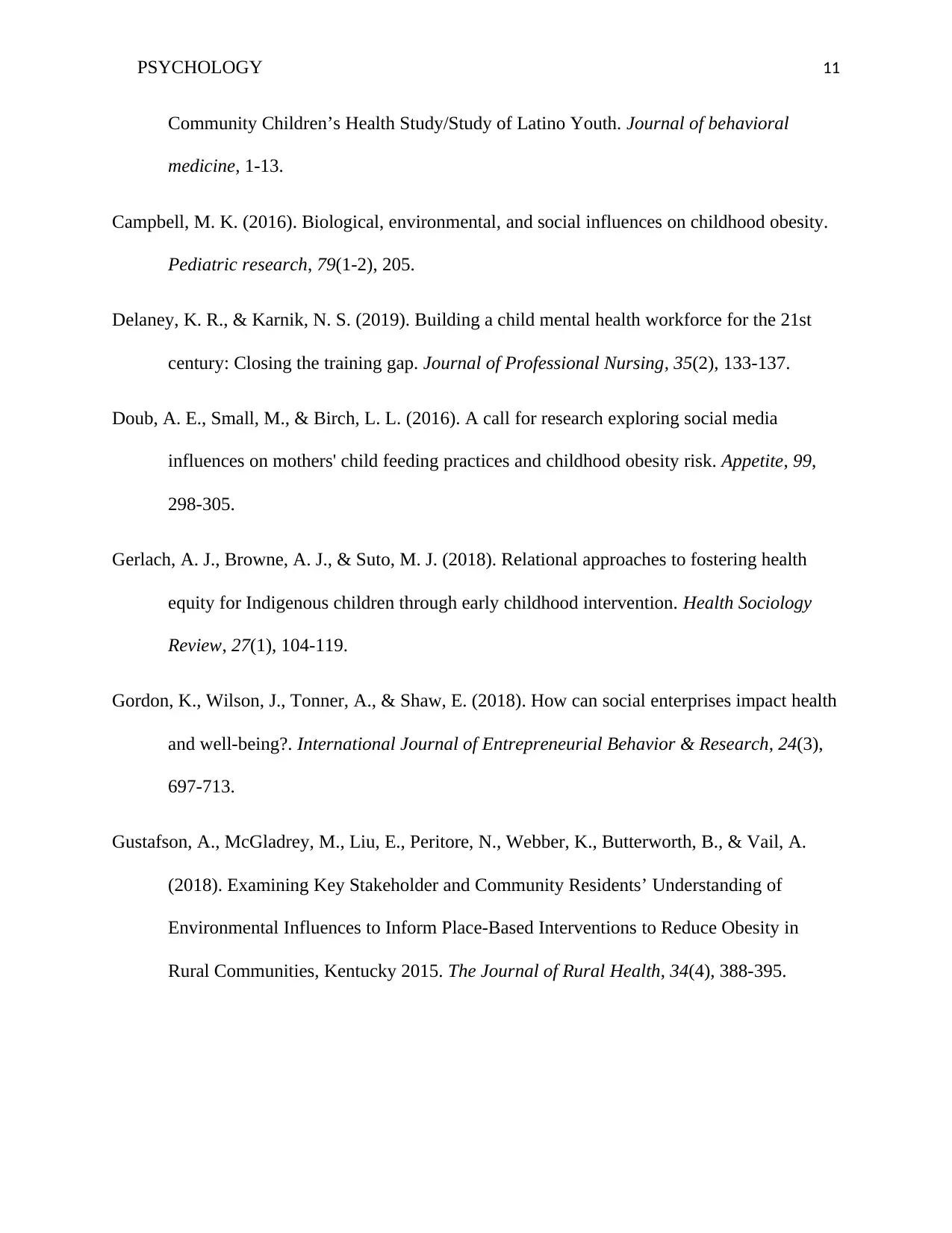
PSYCHOLOGY 11
Community Children’s Health Study/Study of Latino Youth. Journal of behavioral
medicine, 1-13.
Campbell, M. K. (2016). Biological, environmental, and social influences on childhood obesity.
Pediatric research, 79(1-2), 205.
Delaney, K. R., & Karnik, N. S. (2019). Building a child mental health workforce for the 21st
century: Closing the training gap. Journal of Professional Nursing, 35(2), 133-137.
Doub, A. E., Small, M., & Birch, L. L. (2016). A call for research exploring social media
influences on mothers' child feeding practices and childhood obesity risk. Appetite, 99,
298-305.
Gerlach, A. J., Browne, A. J., & Suto, M. J. (2018). Relational approaches to fostering health
equity for Indigenous children through early childhood intervention. Health Sociology
Review, 27(1), 104-119.
Gordon, K., Wilson, J., Tonner, A., & Shaw, E. (2018). How can social enterprises impact health
and well-being?. International Journal of Entrepreneurial Behavior & Research, 24(3),
697-713.
Gustafson, A., McGladrey, M., Liu, E., Peritore, N., Webber, K., Butterworth, B., & Vail, A.
(2018). Examining Key Stakeholder and Community Residents’ Understanding of
Environmental Influences to Inform Place‐Based Interventions to Reduce Obesity in
Rural Communities, Kentucky 2015. The Journal of Rural Health, 34(4), 388-395.
Community Children’s Health Study/Study of Latino Youth. Journal of behavioral
medicine, 1-13.
Campbell, M. K. (2016). Biological, environmental, and social influences on childhood obesity.
Pediatric research, 79(1-2), 205.
Delaney, K. R., & Karnik, N. S. (2019). Building a child mental health workforce for the 21st
century: Closing the training gap. Journal of Professional Nursing, 35(2), 133-137.
Doub, A. E., Small, M., & Birch, L. L. (2016). A call for research exploring social media
influences on mothers' child feeding practices and childhood obesity risk. Appetite, 99,
298-305.
Gerlach, A. J., Browne, A. J., & Suto, M. J. (2018). Relational approaches to fostering health
equity for Indigenous children through early childhood intervention. Health Sociology
Review, 27(1), 104-119.
Gordon, K., Wilson, J., Tonner, A., & Shaw, E. (2018). How can social enterprises impact health
and well-being?. International Journal of Entrepreneurial Behavior & Research, 24(3),
697-713.
Gustafson, A., McGladrey, M., Liu, E., Peritore, N., Webber, K., Butterworth, B., & Vail, A.
(2018). Examining Key Stakeholder and Community Residents’ Understanding of
Environmental Influences to Inform Place‐Based Interventions to Reduce Obesity in
Rural Communities, Kentucky 2015. The Journal of Rural Health, 34(4), 388-395.

PSYCHOLOGY 12
Harbec, M. J., & Pagani, L. S. (2018). Associations Between Early Family Meal Environment
Quality and Later Well-Being in School-Age Children. Journal of Developmental &
Behavioral Pediatrics, 39(2), 136-143.
Mackenbach, J. D. (2018). Social, Economic, and Physical Environmental Contributors to
Obesity among Adults. Handbook of Obesity Treatment, 137.
Mazur, A., Caroli, M., Radziewicz‐Winnicki, I., Nowicka, P., Weghuber, D., Neubauer, D., ... &
Hadjipanayis, A. (2018). Reviewing and addressing the link between mass media and the
increase in obesity among European children: The European Academy of Paediatrics
(EAP) and The European Childhood Obesity Group (ECOG) consensus statement. Acta
Paediatrica, 107(4), 568-576.
Ochoa, A., & Berge, J. M. (2017). Home environmental influences on childhood obesity in the
Latino population: a decade review of literature. Journal of immigrant and minority
health, 19(2), 430-447.
Silva, R. A., Rogers, K., & Buckley, T. J. (2018). Advancing environmental epidemiology to
assess the beneficial influence of the natural environment on human health and well-
being.
Sullivan, C. M. (2018). Understanding how domestic violence support services promote survivor
well-being: A conceptual model. Journal of family violence, 33(2), 123-131.
Weissmeyer, S., & Holder, M. D. (2018). Developing and Assessing Strategies to Foster
Children’s Character Strengths and Well-being. Character Strength Development:
Perspectives from Positive Psychology, 44.
Harbec, M. J., & Pagani, L. S. (2018). Associations Between Early Family Meal Environment
Quality and Later Well-Being in School-Age Children. Journal of Developmental &
Behavioral Pediatrics, 39(2), 136-143.
Mackenbach, J. D. (2018). Social, Economic, and Physical Environmental Contributors to
Obesity among Adults. Handbook of Obesity Treatment, 137.
Mazur, A., Caroli, M., Radziewicz‐Winnicki, I., Nowicka, P., Weghuber, D., Neubauer, D., ... &
Hadjipanayis, A. (2018). Reviewing and addressing the link between mass media and the
increase in obesity among European children: The European Academy of Paediatrics
(EAP) and The European Childhood Obesity Group (ECOG) consensus statement. Acta
Paediatrica, 107(4), 568-576.
Ochoa, A., & Berge, J. M. (2017). Home environmental influences on childhood obesity in the
Latino population: a decade review of literature. Journal of immigrant and minority
health, 19(2), 430-447.
Silva, R. A., Rogers, K., & Buckley, T. J. (2018). Advancing environmental epidemiology to
assess the beneficial influence of the natural environment on human health and well-
being.
Sullivan, C. M. (2018). Understanding how domestic violence support services promote survivor
well-being: A conceptual model. Journal of family violence, 33(2), 123-131.
Weissmeyer, S., & Holder, M. D. (2018). Developing and Assessing Strategies to Foster
Children’s Character Strengths and Well-being. Character Strength Development:
Perspectives from Positive Psychology, 44.

PSYCHOLOGY 13
Zhang, J., Tong, L., Lamberson, P. J., Durazo-Arvizu, R. A., Luke, A., & Shoham, D. A. (2015).
Leveraging social influence to address overweight and obesity using agent-based models:
the role of adolescent social networks. Social science & medicine, 125, 203-213.
Zhang, S., de la Haye, K., Ji, M., & An, R. (2018). Applications of social network analysis to
obesity: a systematic review. Obesity reviews, 19(7), 976-988.
Zhang, J., Tong, L., Lamberson, P. J., Durazo-Arvizu, R. A., Luke, A., & Shoham, D. A. (2015).
Leveraging social influence to address overweight and obesity using agent-based models:
the role of adolescent social networks. Social science & medicine, 125, 203-213.
Zhang, S., de la Haye, K., Ji, M., & An, R. (2018). Applications of social network analysis to
obesity: a systematic review. Obesity reviews, 19(7), 976-988.
1 out of 13
Related Documents
Your All-in-One AI-Powered Toolkit for Academic Success.
+13062052269
info@desklib.com
Available 24*7 on WhatsApp / Email
![[object Object]](/_next/static/media/star-bottom.7253800d.svg)
Unlock your academic potential
© 2024 | Zucol Services PVT LTD | All rights reserved.





